
OIRA releases guidance aiming to expand participation in the regulatory review process.
258 days after President Joseph R. Biden signed an executive order aimed at modernizing regulatory review, his Office of Information and Regulatory Affairs (OIRA) has now released final guidance detailing how a crucial part of this evolution would take place.
In Section 2(e) of the executive order, President Biden underscored the importance of fostering public trust in the regulatory process and tasked OIRA with reforming its review procedures. In particular, the order focused on revamping the process for potential participants who are not employees of the executive branch to meet with OIRA officials about regulatory actions.
Under the executive order, OIRA was charged with facilitating the initiation of meeting requests for this group of people “who have not historically requested such meetings, including those from underserved communities.” These meetings—also known as 12,866 meetings—were established under a 1993 executive order signed by President William Clinton and are the target of improvement under Section 2(e) of President Biden’s latest order.
In April of this year, OIRA released draft guidance aimed at satisfying Section 2(e). This opened a 60-day public comment period during which OIRA received approximately 40 comments OIRA also hosted and recorded a listening session in May to gather more feedback from the public about its 12,866 meetings.
With its finalized Section 2(e) guidance issued on December 20, 2023, OIRA published responses and explanations to these public comments and clarified how it will proceed to engage with the public going forward.
OIRA’s 12,866 meetings serve as listening sessions for OIRA officials and provide them with diverse perspectives from the public on whatever regulatory action is under OIRA review. In its new guidance, OIRA underscores that 12,866 meetings are not substitutes for comments submitted to the agency and should center on information relevant to OIRA’s regulatory review process.
The guidance highlights OIRA’s “open door” policy for requesting 12,866 meetings. In essence, this means that any and all individuals or groups can request 12,866 meetings and OIRA will “make all reasonable efforts” to meet with them. OIRA stresses in its guidance that it will never prioritize 12,866 meetings based on an individual’s or group’s viewpoint or identity—such a political affiliation.
Because OIRA’s regulatory review process is often capped at 90 days but also can finish earlier than that, OIRA encourages members of the public to download OIRA’s mobile application version of RegInfo.gov, known as RegInfo Mobile. The mobile app enables users to subscribe to individual regulatory entries for updates without having to check the website continuously.
Noting that some commenters on its draft guidance wanted to revive meetings in person, the final OIRA guidance argues that virtual, audio-only meetings facilitate broader participation and remain more reliable than video meetings. When requesters lack access to the internet, OIRA offers telephone meetings to bridge the gap.
To facilitate more meeting requests in general, OIRA denotes multiple strategies it will pursue going forward. These include offering frequent and accessible training on effective 12,866 meeting participation, encouraging action by agencies to promote 12,886 meetings, and broadening the ways that meetings can be requested.
In addition, OIRA’s guidance points to new written and video instructions—in both Spanish and English—that detail three different ways to schedule a 12,866 meeting. When a meeting is requested, OIRA will send a confirmation email to the requester.
OIRA also emphasizes that people with disabilities should include necessary reasonable accommodations with their meeting requests—or as soon afterward as feasible. Non-English interpretation services remain under consideration. Pending further guidance, OIRA encourages anyone submitting language accommodation requests to do so “as far in advance as possible”.
OIRA states that it seeks to increase access to “underserved communities.” Linking together multiple executive orders, OIRA’s guidance defines underserved communities as “populations as well as geographic communities that have been systematically denied the opportunity to participate fully in aspects of economic, social, and civic life.” Examples of these individuals may include religious and ethnic minorities, people living in rural areas and U.S. territories, women and LGBT individuals, people with disabilities, and people “affected by persistent poverty or inequality.”
The OIRA guidance notes that the vulnerabilities experienced by members of underserved communities can be heightened by geography, language barriers, and lack of access to affordable housing, transportation, health care, and energy.
As it seeks to improve access for new requesters—specifically, those who have not requested meetings with OIRA in the last three years—OIRA states that it will take into account the identity of organizations, not their representatives.
For the “exceedingly rare” cases where OIRA anticipates that will not be able to accommodate all 12,866 meeting requests, the new guidance states that OIRA will first “prioritize requesters who have not historically requested meetings with OIRA, and then self-consolidated requesters.” When OIRA prioritizes self-consolidated requests, the guidance eexplains that OIRA will also notify the public of this ranking on its website.
In addition, because Section 2(e) of President Biden’s executive order also tasked OIRA with discouraging duplicate communications, consolidating meetings, and disclosing data in an accessible format, the new guidance addresses these issues.
The guidance responds to the issue of duplicate meetings by stating a general policy of allowing only one meeting for each requester and each regulatory action under OIRA review. The guidance, however, indicates that OIRA still encourages overall participation in the different stages of OIRA review and recognizes that some coalitions of affected interests might have individual members where each request would not be duplicative.
The guidance tackles meeting consolidation by prioritizing meeting requests for self-consolidated requesters if there is a higher volume of requests than OIRA can handle. The guidance explains that consolidating meeting requests enables participants to express collective opinions while maintaining “an appropriate level of nuance.”
In general, the new guidance advises requesters to be proactive with self-consolidation by reviewing other public comments and the public schedule of meetings. At this time, mandatory consolidation is not contemplated, according to the guidance.
Finally, the new guidance indicates that public disclosure surrounding agency meetings with outside parties has always been “a cornerstone of a fair an transparent regulatory review process.” Currently, OIRA discloses for each 12,866 meeting the subject, date, names, affiliations, and written materials provided by participants.
The new guidance announces that OIRA will expand its disclosure to include optional narrative descriptions provided by the requesters. In addition, OIRA will start requiring the name and organization of the requester and, if applicable, the individual or organization whose views are being represented.
Furthermore, OIRA will require meeting requesters—the individual participants, not their representatives—to denote any previous requests or participation in 12,866 meetings within the last three years. Along with actual meeting attendance, all the above disclosures will be released in a machine readable and open format.
Overall, this guidance, which President Biden called for to raise transparency and trust in the regulatory process, lays out new policies and methods that seek to pave the way for a modernized OIRA meeting process.



